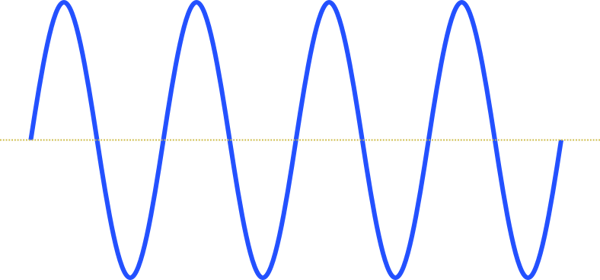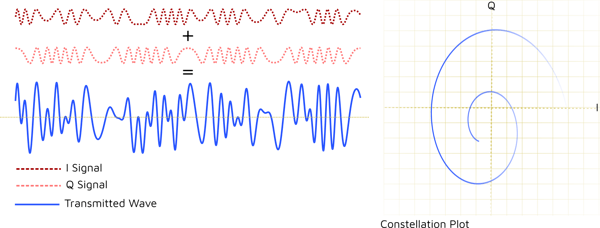How Does Wi-Fi Work? Wi-Fi Fundamentals
Wi-Fi is that mysterious giver of Internet connectivity that travels magically through the air. How does that actually work? It’s a question that’s usually answered with heavy mathematics and impenetrable jargon, but it is possible to get a broad understanding of the physics behind Wi-Fi without equations, science and theory.
A Tour of Waves
Let’s explore waves, abstractly. For now, put aside complications involving the electromagnetic spectrum, radio, wires, voltage, sound... we’re going to think about lines that go up and down and how they are used in communications.

We’ve all seen the sine wave, and they might make us feel all kinds of ways. “Eww, mathematics” is a reasonable reaction. A musician might think of a very pure note. A surfer could see the swell of the ocean. Engineers will see a tool that they can leverage to encode information.
How do they do this? There’s really no one way. In fact, there are all the ways they can think of, including ones they haven’t yet come up with! Since the tail end of the 1800s they’ve been experimenting with waves and conjuring up clever ideas to generate useful signals.

Morse code started with the most obvious technique. Turn the wave on and off to represent the dots and dashes that can be translated to and from letters.

Audio transmissions followed. Instead of turning the wave fully on and off, simply change the amplitude of the wave to match the loudness of a voice or musical instrument. At the other end of the transmission trace the amplitude of that modulated sine wave and you’ve got AM radio; amplitude modulation.

On the radio dial, AM’s counterpart is FM. Knowing that the F stands for frequency is a clue about how instead of changing the amplitude of the wave, the frequency is changed. Engineers might choose FM over AM because the modulated wave is always the same volume, wastes less energy and is easier to separate from overlapping noise amongst other properties, at the expense of complexity.

People who like to think about things like numbers that are imaginary and concepts like orthogonality got involved and made things more complicated in an elegant way, as they often do. There’s no need to understand it (unless that’s your kind-of thing), but the result was QAM (quadrature amplitude modulation), where two signals out of phase with each other are combined into a highly efficient signal, seen in technologies such as analog TV.
This is by no means the full selection of techniques used to encode information onto waves, but it does demonstrate how modulating a wave at the source and demodulating it at the destination using any one of a number of techniques is the general pattern used in communicating via waves.
These days the source signal is rarely of an analog nature. We’re more interested in sending ones and zeros; a digital signal. If instead of morse code or sound or TV pictures we think of a source signal that is the square wave representation of digital data, the counterparts to the above modulations make themselves clear:

Mediums
We’ve examined waves in the abstract, but what actually are the waves, physically? How does a diagram of a simple sine wave translate to an actual thing that can be transmitted?
A wave is a disturbance that oscillates back and forth. We hear sound because the air is being compressed and relaxed. A signal travels along a wire representing waves in the changes in its voltage. Radio is broadcast via fluctuations in electromagnetic fields. Our vision works due to cones and rods in our eyes being sensitive to certain electromagnetic frequencies.
The medium chosen for a wave depends on practicalities. It’s possible to imagine a world where instead of linking our computers together via wires and radio waves we chose sound instead! The noise would be unbearable, the data rates would be slow, and you’d lose your connection every time somebody made a noise, but the process of modulating information on a wave would be the same.
Despite the outlandish scenario, it is rare for there to be a wave isn’t converted from one form into another. A device that does this is called a transducer.
Examples of transducers include:
- An antenna, converting a signal in a wire to a radio signal (or vice versa)
- A loudspeaker, converting an electrical signal into a sound wave
- Your eardrums! Converting vibrational waves into an electrical signal that gets interpreted by your brain as sound (spooky)
Wi-Fi
To be useful to us, Wi-Fi travels via radio waves. Its waves are broadcast all around, through the air and walls, giving us convenient access to computer networks wherever we position ourselves. Every engineering decision related to the implementation Wi-Fi was made with practicalities in mind. At each end of a Wi-Fi connection is an antenna, acting as the transducer that turns the radio signal into an electrical signal, at which point it is interpreted in a similar way to wired Ethernet.
Modern Wi-Fi operates mainly in the 2.4GHz and 5GHz radio bands. One reason for this choice is that in most countries it’s legal for consumers and businesses to use these channels for communication (the electromagnetic spectrum is heavily regulated). Each of these bands is split up until channels, which can be viewed as separate spaces for Wi-Fi signals to operate in. This is similar to how local radio stations work. Each one is assigned a precise frequency within the broadcast FM band so that the classic rock station doesn’t interfere with the country music station.
There are also physical reasons for choosing the 2.4GHz and 5GHz bands. Signals with these short wavelengths tend to stay local, a desirable quality for the ranges Wi-Fi works in. It wouldn’t be an ideal situation if it operated in a lower frequency range, producing signals that bounced off the stratosphere and appeared on the other side of the globe!
The signal itself uses a modulation scheme that we didn’t explore above: OFDM.

This scheme uses lots of digital signals using modulation techniques such as QAM to carry data at a slow rate. The signals are spread out next to each other in a way that prevents them from interfering with each other and are broadcast simultaneously. The result looks like a single signal that fills up the available channel space very efficiently, meaning high data rates can be achieved. OFDM also provides other advantages, such as being resistant to “fading” (where copies of the same signal arrive at different times due to bouncing off walls and other features of the environment) and being efficient to implement in low-cost hardware.
A consequence of a signal traveling through the air is that anybody within range can listen to it as easily as the intended recipient, just as somebody can eavesdrop on the sound waves of a spoken message. This is why Wi-Fi is usually deployed with encryption (previously the insecure WEP standard, but now most commonly WPA2).

Wayne Marsh
Wayne is a Principal Solutions Architect who leads the team’s software engineering efforts. Wayne owns rare depth as a technologist with experience in physical mediums such as radio and broadcast, game development, advertising, cyber security, and full-stack development of enterprise solutions.




